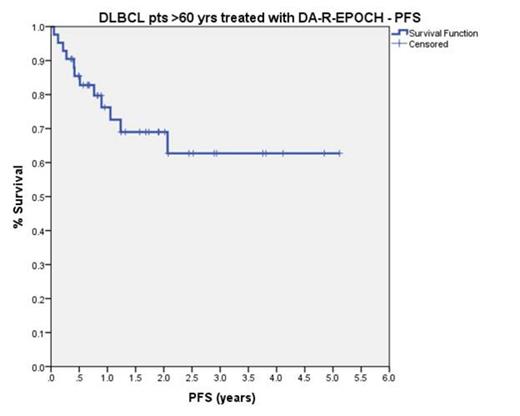Abstract
Background: NHL is a disease of older adults and henceforth the oncology community will be increasingly confronted with the challenges of the older lymphoma patient (pt). Phase II data demonstrates dose-adjusted (DA)-EPOCH +/- rituximab is efficacious in high grade and aggressive NHL (J Clin Oncol. 2008 Jun 1;26(16): 2717-24). Additionally, infusional doxorubicin may confer greater safety in elderly pts compared with bolus delivery. A Phase III trial (NCT00118209) comparing DA-R-EPOCH and R-CHOP has been completed, but the results are not currently available. To date, there is limited data on efficacy and safety in elderly patients treated with DA-R-EPOCH. We explored our single center experience to inform therapeutic choices in older adults.
Methods: We retrospectively reviewed all pts treated with EPOCH at MSKCC from 2003 to 2014, identifying 181 pts in total, of which 54 pts > 60 yrs (out of 73 pts >60 yr) received DA-EPOCH at initial diagnosis. Data was available regarding their baseline characteristics, dose adjustments/treatment modifications, hospitalizations, and disease related outcomes for all pts. Outcome measures included progression free (PFS) and overall survival (OS), hospitalizations, and dose adjustments.
Results: Of 54 patients, histologies included DLBCL (n=42, 78%), T-cell lymphoma (n=8, 15%), and Burkitt lymphoma (BL) (n=4, 7%). The median age of all patients was 70.5 yrs (range 61-93 yrs), with 54% female. Prior malignancy was present in 31% and baseline LVEF was >55% in 98% of pts. For DLBCL patients (n=42): median age 72 yrs (61-92 yr), M:F 24:18, Stage I/II v. III/IV: 21% v. 79%, aaIPI 0-1 v. 2-3: 24% v 76%; cell of origin (Hans) GC/ABC/unknown: 43%/52%/5%. Ki67%: median 90% (range 20-100%). T-cell pts (n=8): median age 68 yrs (61-75 yr), female 50%, histology ATLL(n=4), PTCL (n=3), ALCL ALK- (n=1); 100% adv. stage; BL pts (n=4): ages 65, 69, 82, 81 yrs, 1 early stage, 3 adv. stage, 1 low risk, 3 high risk.
Rituximab was given in 96% of b-cell NHL. Peg-GCSF/GCSF was used with each cycle of EPOCH. A full 6 cycles of EPOCH was completed 52% of the time and dose adjusted in 66% of pts with a median of 4 adjusted cycles/pt (range 1-6). Dose increases occurred in 30% of pts, dose decreases 26%; 11% of pts started at dose level -1.
Safety: Cardiac events occurred in 22% of pts, with 2 pts experiencing anthracycline induced cardiomyopathy/CHF, the remainder included G ≥3 arrhythmias (n=6) or chest pain/angina (n=4) without change in EF. Hospitalization for G≥3 toxicity occurred in 68.5% (n=37) of pts (41% more than once): neutropenic fever/infection (n=19/9), AKI/dehydration (n=7), syncope (n=2); Treatment related mortality was 4% (n=2).
Outcomes: With a median followup of 1.5 yrs, 33 of 54 pts remain progression free (DLBCL 30/42, TCL 1/8, BL 2/4, p=0.007). For all pts, median PFS and OS have not been reached: PFS and OS at 1.5 yr is 57% and 66%, respectively. For DLBCL pts, median PFS and OS is not reached: PFS and OS at 1.5 yr is 69% and 78%, respectively. In log-rank analysis: aaIPI (p=.15), Stage (p=.08) and cell of origin (p=.35) did not predict OS; aaIPI (p=.05) and stage (p=.04) predicted PFS, but cell of origin was not significant. There was no significant difference in outcome based on dose adjustments.
Conclusions: DA-EPOCH +/- R is an effective treatment option for pts > 60 yrs with advanced stage, high risk DLBCL; Hospitalizations for toxicity were frequent, but TRM was low. Cardiomyopathy was infrequent. Dedicated efforts to explore initial dose-reductions and optimal number of cycles in this older pt population would be beneficial.
No relevant conflicts of interest to declare.
Author notes
Asterisk with author names denotes non-ASH members.


This feature is available to Subscribers Only
Sign In or Create an Account Close Modal